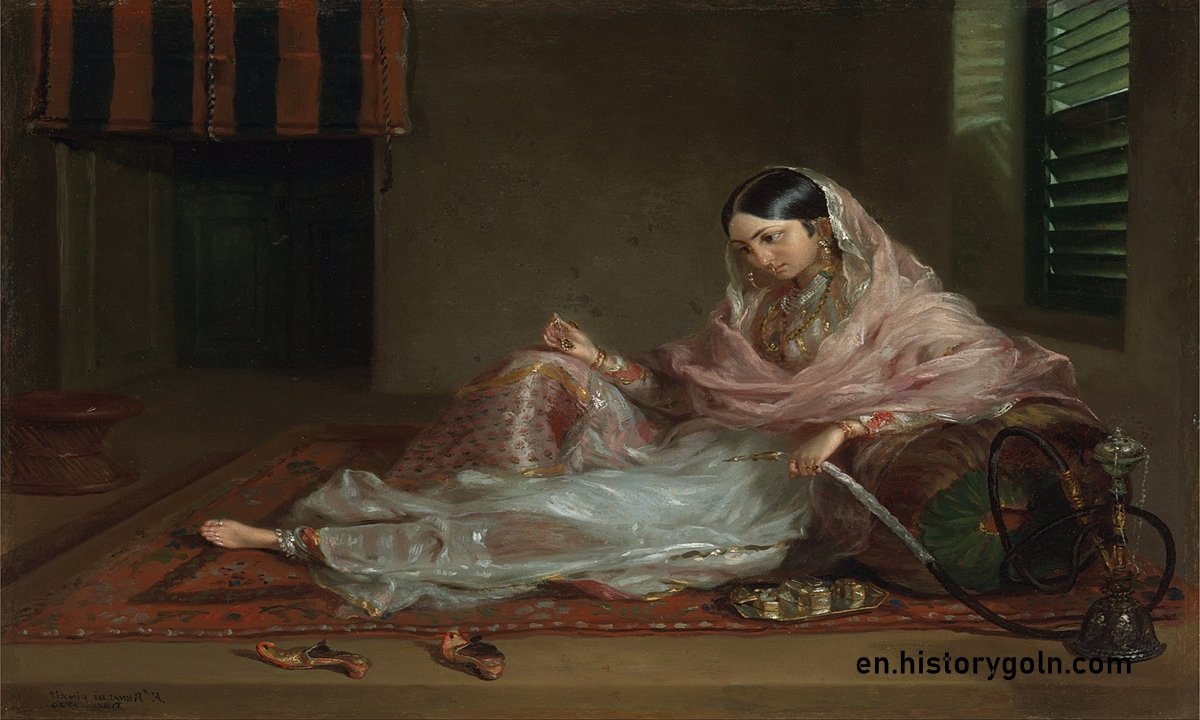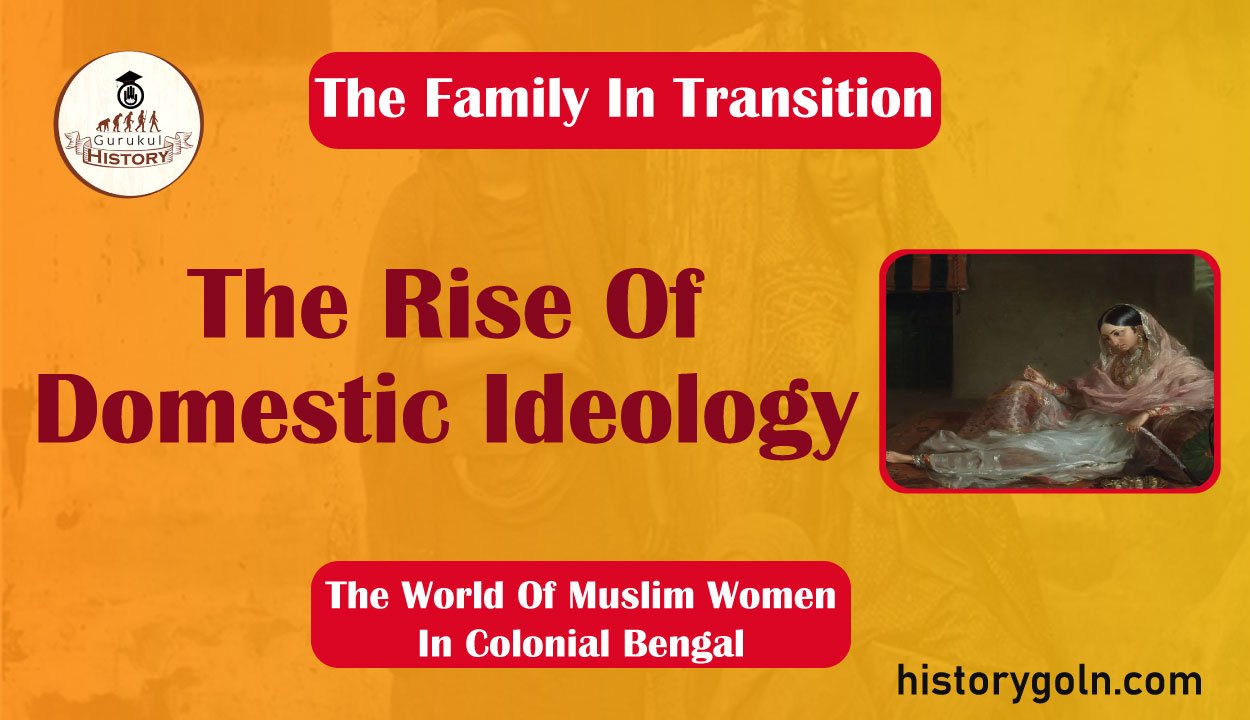Today our topic of discussion is The Rise Of Domestic Ideology .
The Rise Of Domestic Ideology

England’s dominion overseas often imported ideologies from abroad as a consequence of its forced cultural encounter with the West. Ever since Macaulay’s famous Minute proclaiming the necessity for creating a class of people “Indians in blood and colour, but English in taste, opinion and morals”, the process of hegemonic acculturation had accelerated.
The bhadrolok-Indians who had received western education and imbibed the post-enlightenment spirit of Europe to some measure– started to refashion their own traditional values and social structures.
Liberal ideologies imported from the West underwent a sea change and assumed hybrid forms in their journey eastward. One of the strong influ- ences in the cultural sphere of the bhadro community in Bengal was that exerted by the rise of a new form of domestic ideology in Victorian England (1837-1901) which produced the Perfect Lady. She was the new, middle class woman, wife, mother, helpmeet and companion, mistress of the private sphere, submissive appendage to the modern male breadwinner.
The new model of femininity held considerable sway in England from about the time of Queen Victoria’s ascension in 1837 until the 1870s. It was based upon a new concept of woman’s innate nature, as fragile, pure and tender. Along with theories of separation and complementarity of spheres, it was a component element of a new domestic ideology that dominated Victorian England.
After the French Revolution of 1789, the English middle class deeply anxious about the stability of their own society felt that one of the chief ways of ensuring social stability would be to strengthen the idea and role of the bourgeois family “male bread-winner, dependent home-based, wife and children.
The pre-industrial family where all members contributed in some measure to the productive process and hence the family income, had broken down and given way to the new version which separated human social existence into two spheres the home and the outside, the private and public. Prior to this the feminine ideal had been the Perfect Wife who had been an active participant in the family, fulfilling a number of vital tasks.
In the lower classes she had contributed to the family income; in the middle classes she had provided economic support by caring for children, purchasing and preparing food, etc. But in a changed cultural and econ- omic milieu the model gave way to an ideal which had little connection with “any functional and responsible role in society.
Publicists and poets contributed much to the development of domestic ideology by articulating discourses on the separation and complementarity of spheres (Ruskin’s Sesame and Lilies, 1865, Tennyson’s The Princess. 1847) and the submissive nature of woman (Sarah Ellis, Ruskin, Tennyson). A girl was now trained to imbibe the above ideas- she believed a woman’s world was in the home:
In her most perfect form the lady combined total sexual innocence, conspicuous consumption and the worship of the family hearth.7 Her education and training were designed to bring out her ‘natural subm- ission to authority, and innate maternal instincts. Mrs. Sarah Stickney Ellis, best selling writer and ‘mid century pundit’ wrote:
As women, then, the first thing of importance is to be content to be inferior to men inferior in mental power, in the same proportion that you are in bodily strength.
Ruskin’s versions of girls as flowers to be picked was the norm, and Mill’s marriage between equal partners was the exception.”
One important point of dissimilarity between the ideal prescribed in Victorian (later also in Edwardian, 1901-1910) England and colonial India was the attitude to marital sex. As noted before, the Muslim manuals had elaborate chapters on sexual duties of males and females.
Sex was a matter of joy and matrimony, ideally, was supposed to provide sexual fulfillment for both partners. Therefore girls/wives were enjoined to tempt, to please. to participate (if possible), and above all to satisfy their husbands. The Victorian ideal of the ‘passive’ female partner was not upheld, or approved of.
But as the bhadromohila ideal spread, bhadro/Victorian ‘puritanism’ also gained ground. The message of the perfect lady in England and her pivotal role in the domestic sphere, were widely publicized from the pulpit, in religious tracts and popular manuals, in popular literature and art forms, in the streets and business places, in schools and social centres.
However, like all stereotypes/ideals, it would be difficult to locate the perfect lady in concrete terms. A prescribed ideal of womanhood was one thing, the humdrum reality of daily life, another.
It was difficult to find a woman who was idle, innocent, childlike, and lived off the money provided by the male breadwinner to create the sanctuary of home. But even among the upper classes scholars 10 who have examined the economic realities of middle class existence argued that there was little scope for these families to employ a legion of servants and for the wife to remain idle and indisposed.
The importance of the ideal then was in the normative or prescriptive power it had among the middle class women who represented it, the working class women who emulated it and the upper class who exemplified it. In real life what one could expect to find was a diluted version of the Perfect Lady cum Good Wife, who though she could not afford idleness, could be respectable, chaste and virtuous.

It is incidentally in this diluted version or this imperfect copy of the Perfect Lady that one sees the prototype of the later house- wife, and in this legacy the Perfect Lady was to continue to exert influence.
The Perfect Lady as an ideal or stereotype soon had to make room for a new model, the ‘perfect woman” or “…The new woman who continued to hold chastity as an ideal but made it equally applicable to men as to women. 12 More importantly, through a variety of economic and social changes her sphere of action became greatly enlarged.
The transition in the mode of the family in nineteenth century Bengal, first among the Hindu/Brahmo community and then the Muslim, may be viewed as a movement from the andarmahal/antahpur to the ‘griha”. As observed by Himani Banerjee:
The two central themes in this context are the familial social space designated as ‘andarmahal/antahpur (inner quarters) and ‘griha’ (home/household) and the main creator-organizer of this space, who is named in the latter half of the century as ‘grihini'(the mistress of the home/home-maker) especially in her incarnation of bhadra- mahila as mother the newness of the concept of griha (now) and its difference from andar (then) stare us in the face.
This andar/antahpur which indicates a social domain in women’s care, which is the constant inhabitat of women, children, domestic servants and the nocturnal habitat of adult males, can only be understood in its specificity when contrasted with griha.
From the 1850s onwards, Bengal’s most eminent social reformers the Brahmos, deemed improving the condition of women a central feature of their reformist programme.
In this they were considerably affected by the culture and values of the Victorian/Edwardian eras based on the political. philosophical and economic tenets of Liberalism, Unitarianism and Utili- tarianism. Their most renowned reformer Keshub Chandra Sen “had been profoundly influenced by Victorian ideas of social reform, which had reached him through correspondence with English Unitarians, contact with English administrators in India and a visit to England.
In 1863 Keshub’s followers established the Bama Bodhini Sabha for Brahmo women which brought out the Bama Bodhini Patrika till the 1920s. After a major split in the Brahmo Samaj in 1878 Keshub continued to rede- fine the traditional Hindu ideals of womanhood in accordance with middle class Victorian values.
The rise of the new domestic ideology with its emphasis on companionship, love, efficient household management, and sepa- ration of private and public spheres, was first articulated in the Brahmo community.
The new ideology in its Bengali context, helped shape the contour of the new family and the personality of the bhadromohila into whose hand the care of the family was entrusted. The Brahmo/Hindu bhadromohila in her turn served as a model for the later Muslim bhadro- mohila. When the new generation of Bengal Muslims came upon the scene they found a model of women’s reform already in existence.
In the early twentieth century the conservatives referred to this new generation disapprovingly as the Mill-Bentham addicted “Nabya Muslim Sam- praday 15 (community of New Muslims) who played a pivotal role in the making of the new Muslim gentlewoman.
The ‘new woman cum perfect lady’ viz the women of colonial India who felt the first full brunt of ‘modernization 16 sought education, creative exp- ression (through writing), a meaningful role outside the home-bound one, and fought for legal and political rights. Economic independence per se was not part of their agenda initially.
Where women of England in the Edward- ian age could if she desired, seek some form of employment outside the home, for Bengali women it was not an option in the early part of the twentieth century (though working class women were employed in jute mills at the time).

This, despite the fact that Indian women were participating in the anti-colonial struggle. Women were seen in large numbers in public rallies, demonstrations, protests and marches; but there was neither oppor- tunity nor ideological sanction for women of the middle class to seek emp- loyment in the early decades of the twentieth century.
For many middle class women of Victorian and Edwardian England, mar- ringe was the most attractive option. For Indian women it was the only one. As our discussions in the following sections will show, the new domestic ideology of this period celebrated woman as homemaker, mother and compa- nion, not as an unseemly wage-earner.
See more:
